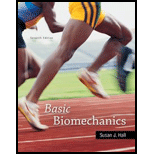
Basic Biomechanics
7th Edition
ISBN: 9780073522760
Author: Susan J Hall
Publisher: McGraw-Hill Education
expand_more
expand_more
format_list_bulleted
Concept explainers
Textbook Question
Chapter 3, Problem 10IP
Two children sit on opposite sides of a playground seesaw. Joey, who weighs 220 N, sits 1.5 m from the axis of the seesaw, and Suzy, who weighs 200 N, sits 1.7 m from the axis of the seesaw. How much torque is created at the axis by each child? In which direction will the seesaw tip?
Expert Solution & Answer
Want to see the full answer?
Check out a sample textbook solution
Chapter 3 Solutions
Basic Biomechanics
Ch. 3 - Prob. 1IPCh. 3 - How much force must be applied to a 0.5-kg hockey...Ch. 3 - A rugby player is contacted simultaneously by...Ch. 3 - Prob. 4IPCh. 3 - Draw the horizontal and vertical components of the...Ch. 3 - A gymnastics floor mat weighing 220 N has...Ch. 3 - What is the volume of a milk crate with sides of...Ch. 3 - Prob. 8IPCh. 3 - If the contents of the crate described in Problem...Ch. 3 - Two children sit on opposite sides of a playground...
Ch. 3 - Prob. 1APCh. 3 - Gravitational force on planet X is 40% of that...Ch. 3 - A football player is contacted by two tacklers...Ch. 3 - A 75-kg skydiver in free fall is subjected to a...Ch. 3 - Use a trigonometric solution to find the magnitude...Ch. 3 - Prob. 6APCh. 3 - In the nucleus pulposus of an intervertebral disc,...Ch. 3 - Prob. 9APCh. 3 - Two muscles develop tension simultaneously on...
Knowledge Booster
Learn more about
Need a deep-dive on the concept behind this application? Look no further. Learn more about this topic, bioengineering and related others by exploring similar questions and additional content below.Similar questions
- Briefly define the types of joint movements available at a ball-and-socket joint.arrow_forwardMovement at the shoulder joint that moves the upper limb laterally away from the body is called ________. elevation eversion abduction lateral rotationarrow_forwardWatch this video (http://openstaxcollege.org/l/flexext) to learn more about the flexion and extension of the knee, as the femur both rolls and glides on the tibia to maintain stable contact between the bones in all knee positions. The patella glides along a groove on the anterior side of the distal femur. The collateral ligaments on the sides of the knee become tight in the fully extended position to help stabilize the knee. The posterior cruciate ligament supports the knee when flexed and the anterior cruciate ligament becomes tight when the knee comes into full extension to resist hyperextension. What are the ligaments that support the knee joint?arrow_forward
- Watch this video (http://openstaxcollege.org/l/anklejoint3) to learn about the ligaments of the ankle joint, ankle sprains, and treatment. During an inversion ankle sprain injury, all three ligaments that resist excessive inversion of the foot may be injured. What is the sequence in which these three ligaments are injured?arrow_forwardWhich of the following is a type of synovial joint? a synostosis a suture a plane joint a synchondrosisarrow_forwardVisit this site (http://openstaxcollege.org/l/kneesurgery) to perform a virtual knee replacement surgery. The prosthetic knee components must be properly aligned to function properly. How is this alignment ensured?arrow_forward
- Figure 38.37 Which of the following statements about muscle contraction is true? The power stroke occurs when ATP is hydrolyzed to ADP and phosphate. The power stroke occurs when ADP and phosphate dissociate from the myosin head. The power stroke occurs when ADP and phosphate dissociate from the actin active site. The power stroke occurs when Ca2+ binds the calcium head.arrow_forwardSupination is the motion that moves the ________. hand from the palm backward position to the palm forward position foot so that the bottom of the foot faces the mid line of the body hand from the palm forward position to the palm backward position scapula in an upward directionarrow_forwardWhich statement is tine concerning the knee joint? The lateral meniscus is an intrinsic ligament located on the lateral side of the knee joint. Hyperextension is resisted by the posterior cruciate ligament. The anterior cruciate ligament supports the knee when it is flexed and weight bearing. The medial meniscus is attached to the tibial collateral ligament.arrow_forward
arrow_back_ios
arrow_forward_ios
Recommended textbooks for you
 Principles Of Radiographic Imaging: An Art And A ...Health & NutritionISBN:9781337711067Author:Richard R. Carlton, Arlene M. Adler, Vesna BalacPublisher:Cengage Learning
Principles Of Radiographic Imaging: An Art And A ...Health & NutritionISBN:9781337711067Author:Richard R. Carlton, Arlene M. Adler, Vesna BalacPublisher:Cengage Learning Human Physiology: From Cells to Systems (MindTap ...BiologyISBN:9781285866932Author:Lauralee SherwoodPublisher:Cengage LearningSurgical Tech For Surgical Tech Pos CareHealth & NutritionISBN:9781337648868Author:AssociationPublisher:Cengage
Human Physiology: From Cells to Systems (MindTap ...BiologyISBN:9781285866932Author:Lauralee SherwoodPublisher:Cengage LearningSurgical Tech For Surgical Tech Pos CareHealth & NutritionISBN:9781337648868Author:AssociationPublisher:Cengage


Principles Of Radiographic Imaging: An Art And A ...
Health & Nutrition
ISBN:9781337711067
Author:Richard R. Carlton, Arlene M. Adler, Vesna Balac
Publisher:Cengage Learning


Human Physiology: From Cells to Systems (MindTap ...
Biology
ISBN:9781285866932
Author:Lauralee Sherwood
Publisher:Cengage Learning

Surgical Tech For Surgical Tech Pos Care
Health & Nutrition
ISBN:9781337648868
Author:Association
Publisher:Cengage

GCSE PE - ANTAGONISTIC MUSCLE ACTION - Anatomy and Physiology (Skeletal and Muscular System - 1.5); Author: igpe_complete;https://www.youtube.com/watch?v=6hm_9jQRoO4;License: Standard Youtube License